growing cacao in Hawaii
We’ve explored the island of Oahu and some of the fabulous Hawaiian chocolate produced there in the past few posts. I’d now like to share some of what I learned while visiting cocoa farms and plantations on the island.
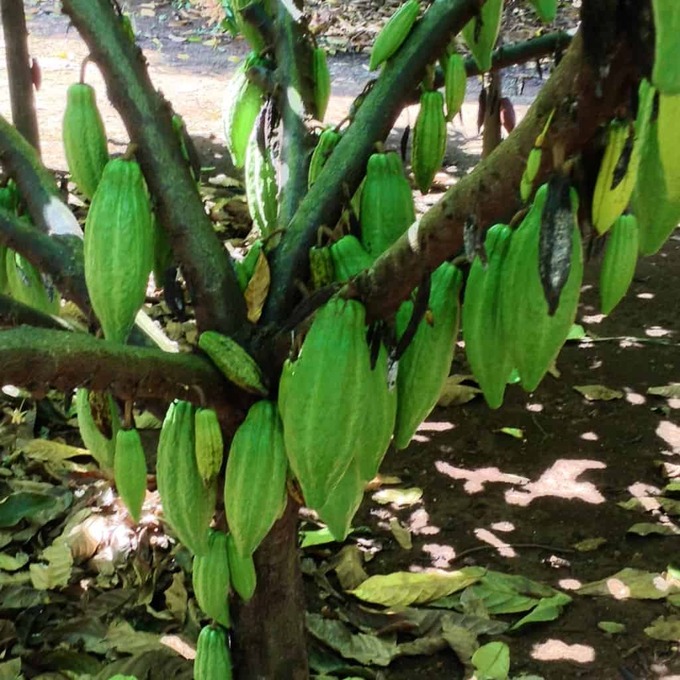
I’ve never seen such a dense concentration of cocoa pods as I did on the cacao trees of the Waialua Estate on Oahu.
growing cocoa on American soil
Usually, the growing of cacao (cocoa) has been limited to a belt 20 degrees north or south of the equator. It’s only since the 1980’s that cocoa has been grown in Hawaii in any quantity–which is at 21-22 degrees latitude. You’ll now find about 100 planted acres of cacao growing on the islands of Oahu, the Big Island of Hawaii, and lesser amounts on the islands of Maui and Kauai, with the amount of cacao grown in Hawaii increasing by 25% each year.
In 2013, there were 30,700 pounds of cocoa beans harvested in Hawaii. Of that, 24,500 was grown on Oahu, 5,600 pounds on the Big Island, 580 pounds on Maui, and 100 pounds on Kauai. It’s good to know that production is on the increase, as demand for Hawaiian cocoa far exceeds the amount of beans currently grown.
I had the pleasure of being invited to participate in the 2014 field trip of the Hawaii Chocolate and Cacao Association that took me to several of the 16 test sites where cacao is being grown and studied with respect to grafting and fertilization techniques as well as disease control. We also visited the largest private cocoa estate on the island of Oahu. I’ve seen cacao growing in South America and the Caribbean and learned that each growing region has its own unique challenges when it comes to growing cacao. Hawaii is no exception, where the Chinese rose beetle is the main challenge to growers.
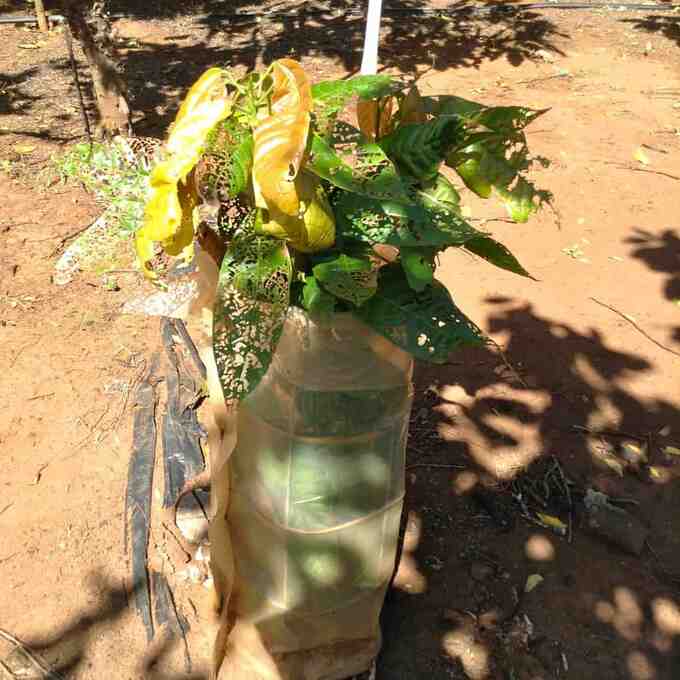
Cacao seedlings on Oahu are being attacked by Chinese rose beetles.
To combat further devastation to cocoa seedlings from the rose beetles, growers wrap the trunk in a heavy plastic to prohibit the beetles from crunching on the seedlings. As well, they use LED lights to keep the cocoa fields lit during the night. It seems the beetles only come out in the dark, so light is projected onto the young cocoa trees from dusk until dawn, discouraging the damaging vermin from eating the young tender leaves of the seedlings. I’m told that grasshoppers are a challenge on Maui.
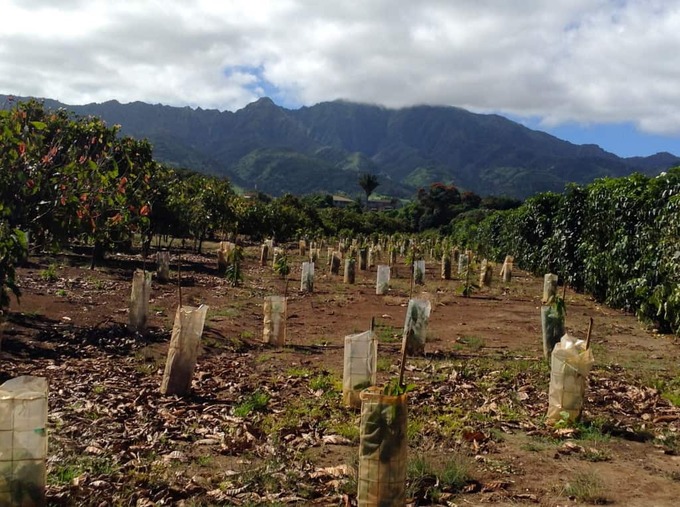
Cacao seedlings on the Waialua Estate are wrapped in heavy plastic to protect them from the Chinese rose beetles.
At present, chocolate makers and chocolatiers in Hawaii have to partially rely on imported cocoa to make their chocolates as there just isn’t enough cocoa grown on the islands of Hawaii to meet the demand. And due to higher production costs, the price for cocoa grown on Hawaii is considerably higher than what chocolate companies have to pay for imported beans or couverture. But it appears that is changing, and Waialua Estate (owned by Dole), now has 25 acres of cocoa planted alongside its 200 acres of coffee. They are making some excellent chocolate from those beans — most notably the Waialua Estate 55% semisweet bar adorned with Hawaiian cocoa nibs.
You’ll find that cacao is often grown on the same property as coffee as they require similar growing conditions. No wonder their flavours go so nicely together!
In another post, I talk about the Original Hawaiian Chocolate Factory on the Big Island. It is one of few locales in the Hawaiian Islands where the cocoa is grown on the same site as where the chocolate is made. Their cocoa nibs are absolutely fantastic!
Have you been to a cacao plantation in Hawaii? Have you tried bean-to-bar made in Hawaii craft chocolate made from Hawaiian-grown cocoa beans? It has a taste like no other.
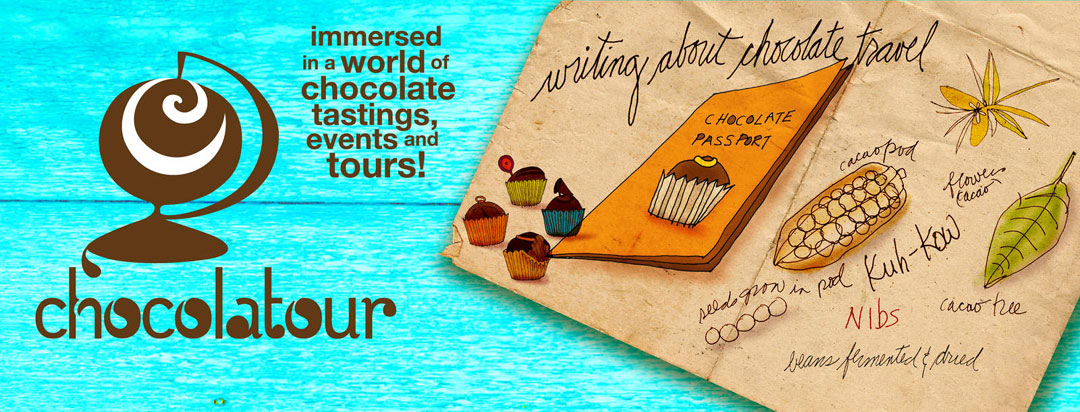







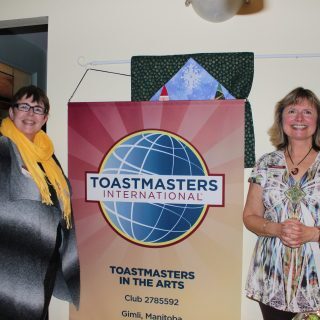
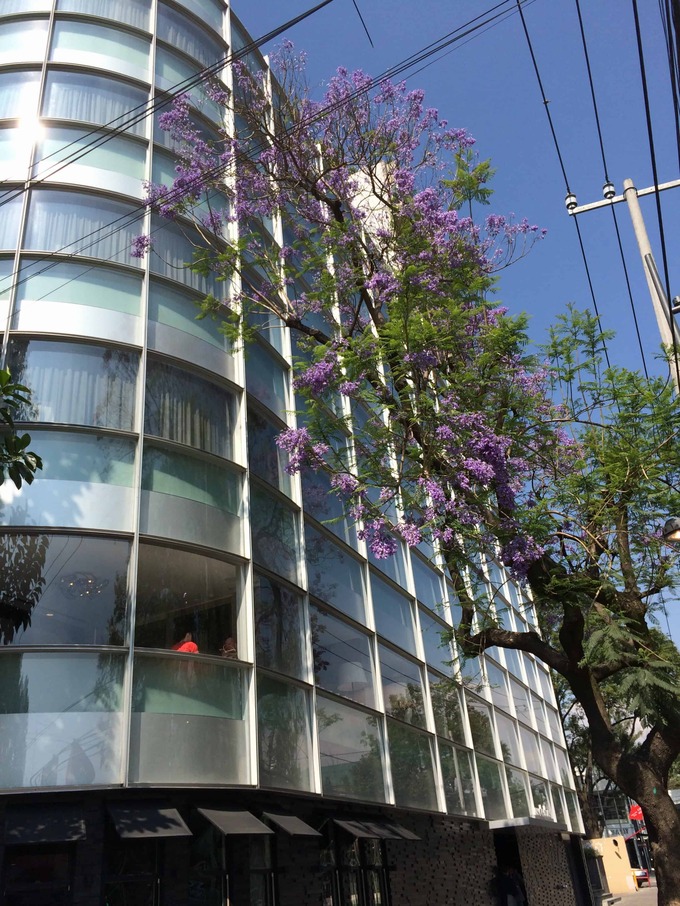
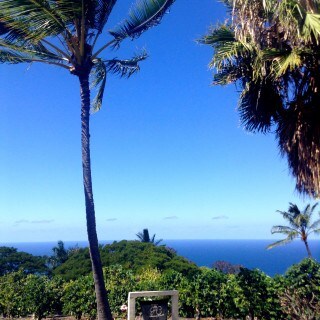
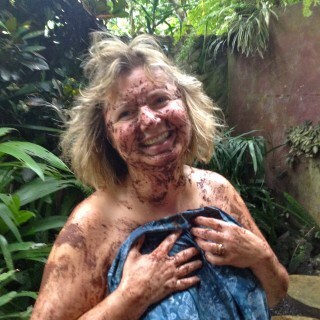
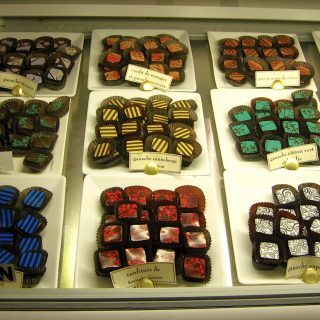

The positivity of your writing is a light in the darkness.
Keep up the good work!
I live on the big island and I’m a big consumer of local cacao, but fresh and making my own chocolate from the nibs. but I’m trying to find out is how the level of cum and lead in local Kakao compares to that of everywhere else because I eat a lot of chocolate I’m a little bit worried that I might be consuming too much but I’d like to know if Hawaii volcanic soil is higher or lower in cadmium and I can’t seem to find that information anywhere. only Neves On Maui Claims to have a rating of their chocolate at .3 mg. Does anyone have any information about the big island?
Hello, Mike and thx for your comment. I suggest you contact the Hawaiian Cacao Association at https://hawaiichocolate.org and see if they might have an answer for you. They have a lot of dedicated people working to help continue to move the cacao industry in Hawaii forward on a positive path.
Awesome, We are in Oahu which we love the chocolate macadamia nuts, so I planted a backyard Cacao tree , so far it is growing and doing good, I need to water more often because the heat. I can’t wait for this Cacao to bear fruits, on my own backyard.
Hi Maria and thx for your comment. Indeed, chocolate covered or dusted macadamia nuts are fab. The best I’ve had are from the Big Island Candy Company on Hilo. Have you tried them? Good luck with your cacao tree, it will take at least four years before it begins to have pods.
It can take four to 5 years to fruit mature fruit and less if you graft it.
Well, hello, Ethan and welcome to Chocolatour! You will find many posts about growing cacao in different parts of the world, as well as several posts on some of my favourite chocolate makers from Hawaii on this site if you look around.
I look forward to adding Island Sharks Chocolate to my research so that I can include you in the chapter on Hawaii that I’m working on for Chocolatour Volume II.
Thanks for sharing this post with us. I am little bit interested to get more information about growing cacao in Hawaii. I have some experience growing cacao in Hawaii. Keep the seedlings indoors a week to 10 days before planting outdoors. Stop fertilizing, cut watering down to half the amount, keep then in a cooler inside space. Then start letting them receive some direct sunlight and introduce them to outdoor temperatures. You can start by placing the trays outside for about an hour during mid day and increase gradually the time spent outdoors. You do not want them out when it is cold, in heavy rain, strong winds and bring them inside during the night.
Aloha , I am interested in learning and doing a study on growing the cacao plant and the industry of chocolate here in Hawaii. My hope would be to share it with the 2018 , Honolulu Flower Show, which is more than just flowers. The judges come from National , Garden Club of America. I believe it could help the interest of growing the cacao industry and educate the public . I would love to hear from you and helping me secure some plants that I could grow for the show. Also any other thoughts you may have on this endeavor. Rita Young Riggs.
ryoungriggs@earthlink.net
Great Article. As you mentioned, I have definitely seen an increase in the amount of cacao being grown (at least on the Big Island). I have noticed a lot of people growing small amounts on their own properties. Hopefully we will be able to have all cacao made on the BI grown here in the near future.
Hi Doreen,
Thank you for your feature on Hawaiian Chocolate and Cacao. I think you covered the state of the industry quite well in your visit to the islands with visits to local farms, chocolate shops and research areas, your presentation at the Hawaii Chocolate Festival, and 3rd annual Hawaii Chocolate and Cacao Association conference.
We are happy to be included in your blog and upcoming book Chocolatour 2, and it nice to see that many of your readers write in to share their thoughts and comments. Your writings help to promote awareness of the Hawaii Chocolate industry and we all appreciate that. Glad you could come and spend time getting to know the different people and personalities and we look forward to seeing you again.
Aloha!
Derek Lanter,
President Hawaii Chocolate and Cacao Association,
Sales and Operations Manager
Waialua Estate Coffee and Chocolate.
Thanks so much for your comment, Derek, and for your hospitality. I really enjoyed learning about Hawaiian chocolate and cacao from you, Skip, and your other members. Hoping to return again soon, as good chocolate gives me one more reason to love Hawaii.
What a clever idea to wrap in plastic and use lights at night. Great way to prevent pesty bugs and not use pesticides. I love the fact we are trying to grow the coca bean in the US. I used to go to the big Island all the time and I know where the Dole plantation is.
Yikes, Arleen! Just to clarify, it’s cacao/cocoa that we’re talking about here. Coca is the plant used to make cocaine and is largely grown in South America. I was really pleased to see that Peru has gotten rid of all of their cocoa plants and replaced them with cacao from which fantastic Peruvian chocolate is now being made.
Yes, Hawaiian chocolate is really awesome, too, and hopefully an increasing number of acres will continue to be planted with cacao so that the cocoa production will meet the demands of local chocolate makers.
Thanks for stopping by the blog, and for your comment.
I love travelling vicariously with you. Your words, your photos, and your passion for this really put me where you are, or have been.
I’m not sure if I’d ever get to Hawaii, but thanks to you, I’d know exactly where I’d want to go.
Thanks, and continued happy chocolotouring!
How fortunate I am, Christine, to have friends and readers like YOU! You have made my day with your wonderful comment. Thanks for being such a valued member of our community and my world.
You’ve tapped into the heart of chocolate lovers and given them something to think about as well. Who knew that cocoa was this involved. As for me, if there are nuts in that chocolate, I don’t share. It’s all mine.
I know what you mean, Lee. There are certain chocolate creations that I just won’t share.
So would we battle over those Chocolate Turtles?
I’m yet to taste a Hawaiian chocolate. But I bet it tastes good.
What an interesting travel perspective Doreen. Chocolate (used in many forms) is one of the things I’m most intrigued about when we hit Mexico in July (amongst many other hopefully delicious Mexican delights!)
Thanks so much for the comment, Chris, and welcome to my blog!
I’m sure you’ll have some excellent culinary experiences in Mexico. I love it there and am hoping to get back this year for a chocolatour! Have a great trip.
One more reason to love Hawaii! I would love to do a chocolate tour alongside a coffee tour in HI.
Hi Tracie: Yes, I was really pleased to see that Hawaii is now growing cacao and making some great chocolate. As you say, just one more reason to love paradise!
Where have you been all of my life! Oh my goodness I love all of this valuable info! I have only been on one Chocolate tour in Seattle at Theo Chocolate. Currently, that is my favorite tasting chocolate .Loved your post! Thank you!
Hi Suzanne and thanks for your comment. Yes, I’ve had Theo Chocolate and it is good. Haven’t yet been to Seattle for chocolate research (it’s been a long time since I’ve visited the city!) But I hope to soon.
Regarding my chocolate research, you may be interested in the first volume of my book, “Chocolatour: A Quest for the World’s Best Chocolate.” You’ll find out all about it at https://chocolatour.net. Thanks!
Hope they are able to continue to find solutions to overcome some of the problems that have arisen in growing the chocolate in Hawaii. Who knew growing cocoa could be so difficult?
Hi Susan: Yes, I had no idea it was such a challenge to grow cacao! No wonder fine chocolate is so expensive! But worth every penny.
Doreen-what a tough job you’ve got researching for your book!! We have a terrific company here in Boston -Taza- that gives tours. My daughter and I went last year and were amazed at the process. The method they use is from Mexico and it’s a very rustic stone ground chocolate. Different and delicious! Great information.
Hi Alison: Yes, Boston is definitely on my list of places to visit during my research. I tasted Taza several years ago, but not lately, so I would like to taste it again. I am not fond of the courser Mexican-style chocolate, but every once in awhile, I find a company that blows me away with their technique. And methods and tastebuds change, so I am always willing to give it another try. Thanks for dropping in to the blog and for the recommendation.
How interesting! I learned a lot from your article.
Yum! I’m going to Kauai next week. Hope I get to taste some native chocolate!
Lucky you, heading to Kauai, Carole! It’s such a lovely island. Steelgrass Chocolate is a branch-to-bar grower in Kapaa on Kauai’s east coast where you can take an amazing chocolate tour and taste a variety of single origin chocolate. More at http://www.steelgrass.org/chocolate/. Let me know how you like it!
Your research and dedication to chocolate is our gain. Keep it up!
I learned a lot from your post. I had no idea how cocoa was grown, but will hope and pray the beetles stay away. Not sure what I’d do without chocolate
Growing cocoa 101 – a great little lesson! I’ve always been amazed that something so yucky inside can produce such wonderful goodness!
Hi Patti and thanks for your comment.
Yes, it truly is amazing how cacao is magically transformed in delicious coco and chocolates. One of the many wonders of life.
Yes I’ve heard that coffee and cacao are nice companion plants and can grow well in rows along with shading the cacao from the hot sun
I didn’t know they grew chocolate in Hawaii- coffee yes, so I guess it makes sense. Would love to visit one of the sites where it’s grown.
Hi Billie: I wish chocolate did grown on trees! Alas, there is quite a process involved in transforming the raw cacao beans into cocoa mass and cocoa butter, which then go thru even more processing to become chocolate!
Yes, it’s really cool that coffee and cacao often grow in close proximity. You’ll find that to be the case in many regions including Peru, Costa Rica, Mexico, and Hawaii.
How very interesting to learn about the problems of growing these plants. I’m curious to know if these rose beetles are native or somehow were transplanted from another country.
Good question, Neva! I will ask one of the experts I met while in Hawaii.
Hi Neva: I’ve been told that the rose beetle originated in Japan and Taiwan and has now spread throughout Southeast Asia and the South Pacific.
This is fascinating! Added to our travel list – gotta love being able to combine chocolate and Hawaii in one trip.
You got that right, Viv! I was so glad that I finally got back to Hawaii, and that they have so much delicious chocolate and cocoa to entice us! I hope I’ll have the opportunity to return soon.
Seems like chocolate offers so many opportunities for learning about different places and cultures!
Indeed, Irene! I had no idea when I began researching chocolate 5 years ago that this would become my life project! But believe me … I am LOVING it! And I really enjoy sharing the info with you all. Can’t wait to do our 1st group chocolatour. I love the excitement in the room when I do a chocolate talk, but taking it on the road with a group of chocolate-loving women will be a dream-come-true!
I’ve never seen cacao pods before. This was a really interesting article, especially the part about why chocolate and coffee go so well together! Glad to hear we’re working on growing cocoa domestically.
Thanks for the comment, Meredith, and welcome to the blog!
Yes, until I began researching chocolate, I had no idea how chocolate and cocoa were made and that they came from the cacao tree. It truly is a fascinating world.
It must have been quite interesting to see the cacao fields in Hawaii and hear about the challenges faced with growing the crop there. Chocolate lovers are often unaware of all that is involved in creating our treats. I hope things go well with the growing in Hawaii.
Thx for your comment, Donna. Yes, I really find it quite fascinating to see how the cocoa grows in the different countries I have visited, and to see how chocolate makers work with the beans & prepare their chocolate in each country as well. It’s all different, and makes the end product unique from place to place. Glad to share all this info, and much more in-depth coverage will be found in Volume II of Chocolatour. Stay tuned!
Same plant. Grown in different locations. Each with its own set of issues. Wrapped in plastic and covered in light. Who would have guessed?
Exactly, Cheryl! It’s amazing how challenging it appears to be to grow cacao. No wonder pure chocolate is so expensive!